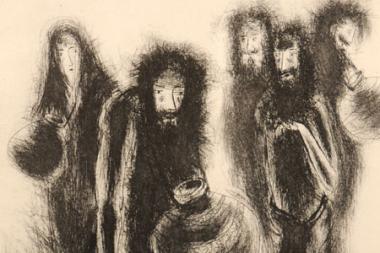As an Indian artist with an international reputation, Savi Savarkar embraces his role as a Dalit (formerly “Untouchable”) and builds his work on a powerfully personal critique of the traditional caste system. An exhibition of his drawings, prints and paintings at the Augusta Savage Gallery, curated by Gary Tartakov, offers an opportunity to see where Savarkar stands as he reaches across cultures.
Take, for example, “Manu,” a two-by-four foot drawing of a monstrous face, with manic malevolence gleaming from the whites of the eyes. The Expressionist style of slashing strokes crosses easily from East to West. But the content mystifies Western eyes and challenges traditional Hindus.
Manu was a great ruler of ancient India, still revered by most orthodox Hindus. As Tartakov notes, the Code of Manu, which defines caste roles and relationships, plays the same cultural and symbolic role that the Ten Commandments serves in Western tradition. But Manu, benevolent lawgiver for the elite within the caste system, is the same Manu that condemns outcasts to lives of persecution, poverty and humiliation. From where Savarkar stands, Manu is truly a monster.
*
Under the Code of Manu, the four castes include Brahmins (teachers, scholars, priests), Kshatriyas (kings, warriors, administrators), Vaishyas (traders), and Shudras (service providers, laborers). Outside the caste system are people with the lowest status and—literally—the dirtiest jobs.
The practice of untouchability is now outlawed in India under Article Seventeen of the Constitution, but over 2,000 years of discrimination don’t disappear overnight. Even the terminology carries baggage. Gandhi called former Untouchables the “Harijan” (Children of God), but some political activists felt that term was patronizing. In the early 1970s, a group of progressive poets forged a new identity for themselves: the Dalit Panthers. “Dalit” means “Oppressed”; “Panthers” references the Black Panther Party for Self Defense.
Tartakov notes that the Dalit Panthers were very knowledgeable about the Black Panther movement in the U.S., and consciously followed a similar path in self-determination. He says, “It’s like going from being called Negro to calling oneself Black, saying ‘I’m going to define myself.’ This shifts agency.”
Self-consciously Dalit, Savarkar fills his artwork, such as the large etching “Pune-Peshwa,” with deeply personal and highly politically symbols. Tartakov guides us through this cultural context, explaining first that the Peshwas were the Brahmin rulers of Pune, ruling the region east of modern Mumbai (where Savarkar was born) from the eighteenth into the nineteenth centuries, and second, that Dalits see the Pune as tyrannical persecutors. He notes, “One of the most famous examples of the zealousness of the Peshwa rule is said to have been their requirement that those they claimed to be outcastes must wear pots around their necks so that if they might chance to spit, anything coming from their supposedly polluting touch would not fall onto a pathway or field, where it might infect someone of the supposedly purer, higher castes.”
In Savarkar’s imagery, Tartakov continues, the spittoon is like the pink triangle and yellow Star of David armbands of Nazi Germany.
Figures within “Pune-Peshwa” suggest an inner vision of Dalit experience. Prominently placed are a man (behind a mask) and a woman, linked together by a fish. Tartakov unravels this as “a complex male of indeterminate status hiding behind his superstition and a generic woman reduced to the vulnerable mechanics of her gender.” Figures on each side display the shameful spittoon, so dominant in defining identity that it becomes the head of the form on the right.
Tartakov continues this tour of layered meanings within this artwork, pointing out that “&the center of the wheel of imagery I have begun with is Savarkar’s—and in some ways India’s—prototypical ‘untouchable,’ the scavenger of dead cattle remains&. It is the Dalit, village servant, whose occupation and life sentence is to remove the carcasses of dead animals from the village. As the presence of the animal’s death is considered polluting to the society, the Dalit serves the society by taking the pollution on himself.”
*
Even today, in the villages of India (where 75 percent of the population still live), Dalits dispose of dead animals. In some rural areas, says Tartakov, “Dalits will be murdered if they refuse to remove the dead body.” Dalit as carcass bearer appears often in Savarkar’s work, also seen in a large etching, “Untouchable with Dead Cow,” and an even larger painting, over six feet tall. Tartakov notes that Savarkar’s Dalit seems to bear the dead cow in triumph, as a punishment endured, “the Dalit iconic equivalent of the Christian’s crucifix….”
Western eyes will notice another potent symbol in Savarkar’s work: the swastika. This emblem goes back more than 2,000 years, says Tartakov, and is popular in India today as a sign of good fortune. But all swastikas aren’t the same. Usually, he notes, the good-luck swastika in India is set straight, in contrast to the swastika on the diagonal, the quintessential symbol for the fascism and anti-Semitism of Nazi Germany.
Savarkar aligns swastikas at an angle to send an angry political message. “He’s slamming traditional Hindus,” says Tartakov. With the swastika, Tartakov continues, “He’s knowingly embracing both traditions. And when he uses a swastika, it’s a double-edged sword, slashing in all directions.” The meaning of the swastika, the spittoon, and other symbols in Savarkar’s artwork lies in the context—and deliberately entangles overlapping cultural, political, and personal perspectives.
“An Untouchable Reaches Out: The Dalit Art of Savi Savarkar,” Augusta Savage Gallery, University of Massachusetts-Amherst, November 2-23, with opening reception November 2 from 5 to 7 p.m.



